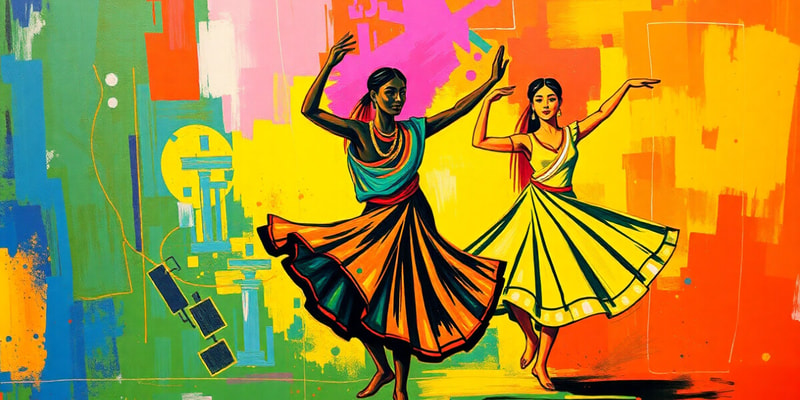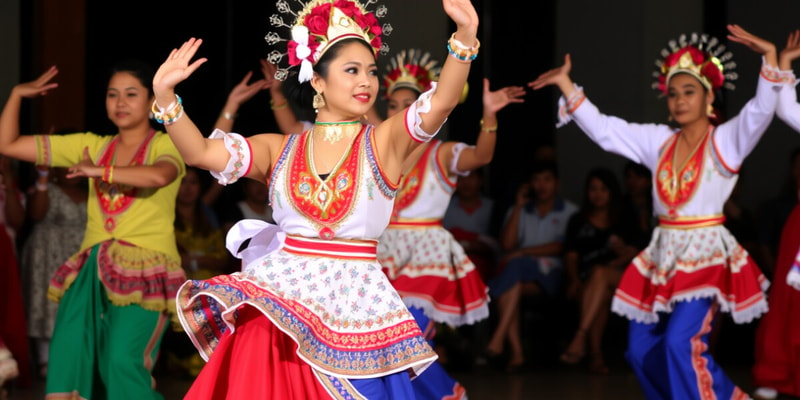Podcast
Questions and Answers
What is Physical Education?
What is Physical Education?
An integral part of the educational program designed to promote the optimum development of an individual physically, mentally, socially, emotionally, and spiritually through total body movement in the performance of properly selected physical activities.
Which of the following is a characteristic of Philippine folk dances?
Which of the following is a characteristic of Philippine folk dances?
What is a Saludo?
What is a Saludo?
A three-step turn in place and a bow to either partner or audience.
What are National Dances in the Philippines?
What are National Dances in the Philippines?
Signup and view all the answers
Can you name one example of an Occupational Dance?
Can you name one example of an Occupational Dance?
Signup and view all the answers
Comic Dances depict serious movements for solemn entertainment.
Comic Dances depict serious movements for solemn entertainment.
Signup and view all the answers
What is the definition of 'Cabeceras' in dance?
What is the definition of 'Cabeceras' in dance?
Signup and view all the answers
Which of the following dance terms refers to the motion of the hands of a clock?
Which of the following dance terms refers to the motion of the hands of a clock?
Signup and view all the answers
What does the term 'Do-si-do' involve?
What does the term 'Do-si-do' involve?
Signup and view all the answers
Study Notes
Physical Education
- Integral component of education promoting holistic individual development: physical, mental, social, emotional, and spiritual.
- Achieved through various physical activities and movements.
Folk Dance
- Considered the oldest form of dance and an early means of communication.
- Distinct self-expression differentiates it from games and gymnastics in physical education.
Characteristics of Philippine Folk Dances
- Dances typically start and conclude with a Saludo, a three-step turn and bow.
- Dancers maintain a distance of 6-8 feet apart, with minimal body contact, primarily hand-holding.
- Most dances are performed in pairs, emphasizing hand movements.
- Dances organized in long formations and are suitable for all ages and both genders.
Classification of Philippine Folk Dances
Geography
- National Dances: Traditional dances across the Philippines sharing basic movements with slight variations. Examples include Carinosa, Kuratsa, Balitaw.
- Local or Regional Dances: Specific to certain locales. Examples include Esperanza (Camarines Sur), Maglalatik (Quezon).
Nature
- Occupational Dances: Representing activities related to occupations, such as Planting and Harvesting.
- Religious or Ceremonial Dances: Associated with religious events, including Dugsu and Putong.
- Comic Dances: Focus on humorous movements for entertainment, e.g., Makonggo.
- Game Dances: Incorporate play elements, such as Pabo and Lubi-Lubi.
- Courtship Dances: Depict romantic interactions, e.g., Hele-Hele, Tadek.
- Wedding Dances: Performed during wedding celebrations, with examples like Pandang-Pandang.
- Festival Dances: Conducted during social gatherings, e.g., La Jota and Kuratsa.
- War Dances: Mimic combat scenarios, such as Sagayan.
Common Dance Terms
- Arms in Lateral Position: Arms held to the side at varying levels.
- Brush: Striking the floor with one foot while the other remains lifted.
- Bilao: Alternating upward and downward palm movements at waist level.
- Cabeceras: Couples positioned at the hall's width in square formations.
- Clockwise and Counterclockwise: Circular movements in the direction of a clock's hands or its reverse.
- Costados: Couples at the hall's length in square formations.
- Crossed Arms: Partners join hands across each other, either R over L or L over R.
- Do-si-do: Partners pass and return to their positions without turning around.
- Free Foot/Hand: Unweighted foot or inactive hand during movements.
Studying That Suits You
Use AI to generate personalized quizzes and flashcards to suit your learning preferences.
Related Documents
Description
Explore the integral role of folk dance in physical education and its unique features. This quiz covers the characteristics, classifications, and cultural significance of Philippine folk dances, enhancing holistic development through movement and expression.




